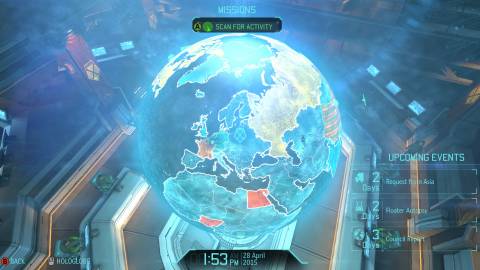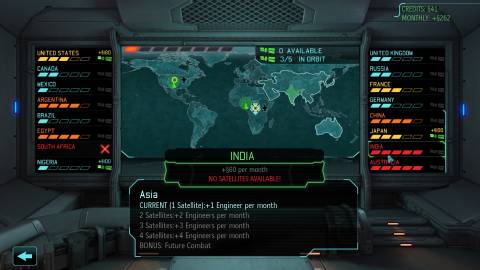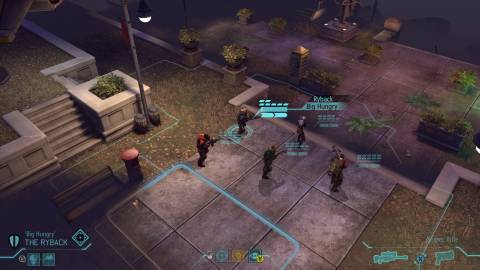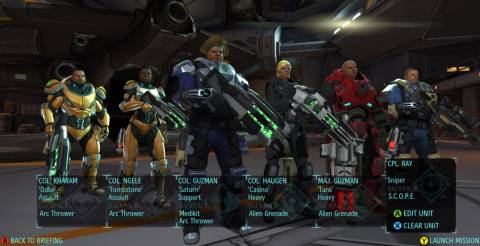
For players of a certain age, MicroProse’s original X-COM: UFO Defense is second in lore only to Sid Meier’s Civilization in its uncanny capacity to devour all of one’s time, one turn at a time. So there’s a weird sense of cosmic balance that Firaxis, developer of all those Civilization games, should be at the helm of XCOM: Enemy Unknown, the first new game to bear that name in more than a decade--and the first one to deserve it in much more than that. The beloved, long-neglected franchise, placed in the assured hands of the veteran developer who’s about as synonymous with turn-based strategy as, say, chess? This is how the universe is supposed to work, right?
Despite the addictive, turn-based parallels, below the surface, Civ and XCOM are very different beasts. There’s a slow-building amiability to Civ, where time is measured in millennia and victory need not necessarily involve guns and ammo. I think it’s important for me to be crystal clear in saying that this is not the case with XCOM: Enemy Unknown. There’s still a “one more turn” seductiveness to the experience, albeit a far more grueling one.
Weight is given to what seems to be a deliberately by-the-numbers alien invasion routine in Enemy Unknown by the fact that your grunts-with-guns military might is so sorely outmatched even by the first wave of invaders, that your only chance for survival--nevermind victory--is to muster up all the help you can. Even--nay, especially--if it means turning the invaders’ own fantastical technology against them. Though the action’s all turn-based, this is a pressure-cooker of a game, where resources are constantly stretched thin, you’re hopelessly outmatched by invading alien forces, and every choice is a tough one, with hard consequences to follow.

While Firaxis has instilled Enemy Unknown with a blistering kind of difficulty as an homage to UFO Defense, the key difference is that, unlike UFO Defense’s babe-to-the-wolves approach, Enemy Unknown spends generous hours peppering lessons about new mechanics into missions, holding back that next wrinkle until that due diligence is done. This isn’t to say Enemy Unknown holds the player’s hand, but that the challenge you face feels fair. Still, there are a lot of moving parts in this game--so many that it can be easy to overlook the importance of any one of them--though to do so is at your own potential detriment. The importance of vigilance cannot be overstated.
Enemy Unknown is a game of two distinctly separate, yet intrinsically connected parts which could, with little embellishment, stand as games on their own. There’s the big picture, presented in diorama at XCOM HQ, your subterranean base. Fighting a losing-odds intergalactic battle takes more than grizzled dudes, though it takes those, too (more on that later). It takes money, resources, engineers, and researchers, with a built-in interdependency between all of them. You need researchers to come up with new and inventive ways to kill aliens; you need engineers to actually build the stuff the boffins in research think up; and you need money and resources collected on the battlefield to put it all together.
Money largely comes in the form of a monthly stipend from individual countries protected by the XCOM program, which can be bolstered by launching satellites over specific countries to provide more vigilant protection. Satellites are rich targets for the alien invaders, which means you need to also invest in airborne protection, which comes with its own expense. Neglect a country for too long, and its panic level will rise to the point that they’ll opt out of the XCOM program permanently, hobbling your finances over the long-term. Additional perks can be had from launching satellites over an entire continent, and you can rake in extra coin by selling bits of alien tech on the Grey Market, though since this is the same stuff you need to build gear for your soldiers on the battlefield, cashing in too liberally has its own drawbacks. It’s all air-tight checks and balances, and part of what makes all of this so excruciating is that you never, ever, have enough money to pursue every avenue you’d like to.

While money's always tight, the most precious resource in XCOM is time, which is richly ironic for a turn-based strategy game. Any action you choose to undertake--researching new alien tech, launching satellites, recruiting new squad members, excavating and building new facilities in your HQ, and more--requires a certain amount of time to complete, with that time dictated by the infrastructure of researchers, engineers, and power sources you have in place. I actually find that I enjoy the jigsaw nature of the administrative part of the Enemy Unknown experience most, though to neglect the battle on the ground is to invite unconditional defeat.
While the clock is ticking ever-slowly while you’re tending to your HQ, the passage of time is accelerated significantly by scanning the globe for alien encounters, be they UFO sightings, abduction alerts, or missions dictated by the game’s surprisingly linear mission structure. Of course, when it rains it pours, and when a mission pops up, you’ll often have to choose between one of several locations, once again forcing you to make the hard choice of which ally to assist at any given moment, with those being ignored reacting in kind. Most of these missions are optional, though that’s only in the loosest sense of the word, since skipping a mission outright will have a crippling effect on your international relations more often than not. It can be awful tempting to let an abduction sighting slide for a couple of days until your next piece of tech has been completed, or your next payday comes around, but again, checks and balances.
Once you actually dive into an on-the-ground mission, Enemy Unknown shifts into small-scale tactical mode, where you control a squad of soldiers, usually between four and six. While they’re not imbued with much distinct individual personality, your (often randomly, hilariously named) international strike force is far from anonymous. Each squad member maintains a persistent experience level for the duration of the game--or, more likely, the duration of their life--ranking up as they score kills in missions. Character classes like sniper, assault, heavy, and support are automatically assigned after their first rank-up, though after that it’s up to you to choose what sorts of class perks they’ll have with each additional rank. The class distinctions, as well as the perks you choose, can have a huge impact on battlefield effectiveness, as classes limit the types of weapons soldiers can carry, and perks can bolster everything from movement range to weapon capacity and accuracy. Rank often correlates to mission survivability, though the sophistication of the gear you equip your squad with--armor, primary and secondary weapons, and accessories--can be just as important. Maintaining a certain amount of class variety is also absolutely crucial, as going into a mission with all snipers is just bad news, I don’t care what rank they are.

What makes all of the character stuff in Enemy Unknown so impactful is the relative fragility of your soldiers when they’re out on the field, and the permanence of their death. There is no virtue rewarded--nor tested--in Enemy Unknown as thoroughly as patience. As you advance your squad into the semi-randomized levels of wilderness, urban clusters, and alien ships and structures--all of them initially cloaked in the fog of war--one turn at a time, it’s all too tempting to rush into things, using both of your soldier’s per-turn actions to plow right into the unknown.
This, along with neglecting to keep your squad members behind bits of still-far-from-impervious cover, is a fantastic way to see them come home in a bodybag. While you’ll be able to salvage any of the pricey gear they were using, once a soldier’s gone, they’re gone, along with all of the time you spent ranking them up. While there are occasions that you can use medikits to save critically wounded soldiers, even if you make it through a mission with your whole squad in one piece, anyone injured on the mission will be out of commission for a commensurate number of days. Your in-game advisors will let you know if you’re running dangerously low on deployable soldiers, or any other vital resources, though if you lack the foresight to keep more than a mission’s worth of soldiers in your ranks, it’s not hard to find yourself facing a mission that you’ve got no one to fight. This can lead to a rapid downward spiral of abandoning countries and dwindling resources.
Most missions consist of locating and exterminating all alien threats, a fantastical menagerie that starts with little grey aliens, moves on to the hideous, zombifying arachnoid Chryssalids, and tops out with the physically frail, yet psychically terrifying Ethereals, among others, each of them requiring their own specific tactics to take down. You’ll occasionally be tasked with rescuing civilians, and there’s a strategic value to bringing your extraterrestrial foes back alive for interrogation. That’s only possible if you equip you soldiers with specialized gear, and invariably requires you get close enough to put the soldier in question directly in harm’s way. Like every action you take on the battlefield, it’s a gamble dictated by a number of variables--information the game makes available, but keeps just out of sight to prevent overwhelming the player with data. Even though the game uses simple percentages to clearly spell out the odds of a successful action, and there’s no reason to believe it’s fudging any of them for dramatic effect, the stakes are so high that every missed shot is absolutely excruciating.

Completing individual missions can take anywhere from fifteen minutes to, well, forever, depending on how liberally you use the game’s optional auto-save system and how obsessive you are about completing missions as cleanly as possible. This is an easy hole to fall down, as even the slightest mistake can snowball rapidly into a world-ending scenario. It can be a frustrating experience, no doubt, particularly when you find yourself in an entirely possible no-win situation deep into a campaign. But it’s rarely, if ever, unclear what action--or inaction--brought about your plight.
Extreme fastidiousness notwithstanding, it can take around 30 hours to see through the single-player campaign in XCOM: Enemy Unknown, though like Firaxis’ Civilization series, there are so many different ways to prioritize the research, engineering, economic, and tactical elements of the game that it almost begs for multiple playthroughs. Add to that a one-on-one tactical multiplayer component that lets you build blended squads of human and alien soldiers, and you’ve got a package that will meet your turn-based strategy needs for the foreseeable future.
It’s also well worth mentioning that, as the first XCOM game developed for consoles as much as it was for PCs, Enemy Unknown’s smartly economic, menu-driven interfaces handle intuitively with a gamepad. In fact, even on the PC, I found myself immediately eschewing mouse-and-keyboard controls in favor of the snappier gamepad controls. With game hardware where it is at the moment, Enemy Unknown naturally looks a bit better and loads a bit faster on the PC, but there’s no real reason not to play the game on whatever your platform of choice is.
The cleverest part of XCOM: Enemy Unknown is how it bundles up all of its complexities and interdependencies and presents them in a package that, while not easy, is at least easily digested. It's often overwhelming, but in the best way possible. XCOM gives no quarter to players with the hubris to think they can play Enemy Unknown at a pace other than the one set by Enemy Unknown. This game will test your mettle in a way that will make old fans tingle with a sense of unforgiving nostalgia, and will make clear to newcomers just exactly what XCOM is all about.